Something that I love about horror, no matter its subgenre, is when it can take something harmless and ordinary—like a rubber ball, or a button, or a VHS tape—and turn it into a symbol of terror. We see this phenomenon play out in horror movies all the time—you can barely mention the Final Destination franchise without someone bringing up that the second installment spooked them out of driving near lumber trucks forever—but what about books that shape how you interact with stuff that really shouldn’t be that scary?
Here are five horror novels that, at some point in my life, really made me rethink what sort of stuff I keep lying around my house.
The Only Good Indians by Stephen Graham Jones

Stephen Graham Jones managed to make ceiling fans scary and I’ll never forgive him for it. The Only Good Indians follows a Blackfeet man named Lewis who is followed metaphorically by his past and very literally by a vengeful spirit. The first time Lewis catches a glimpse of what’s stalking him, it’s while he’s on a ladder in his own home, looking down toward the floor through the blades of his ceiling fan.
I personally have a ceiling fan right above my bed and for weeks after I found myself just…staring at it, grateful that I get to stay below it. I’ll let my fan’s blades get dusty and gross before I’ll climb up there and risk seeing something unexplainable.
IT by Stephen King

You don’t need me to tell you that IT—like any of King’s works—is brimming with nightmare fuel. When I think about IT, though, the scene that always gives me the shivers doesn’t take place in the sewers under Derry, and doesn’t even feature Pennywise the Dancing Clown (and no, it’s not that infamous and controversial scene either).
Rather, the part of IT that haunts me barely spans two pages. It’s an almost throwaway account that adult Mike Hanlon comes across while researching the history of disappearances in Derry. In it, an old man tells how his wife could hear the voices of dead children coming up through the drain of their kitchen sink. Imagine that you just want to drain the nasty old dishwater out of your sink and while the water drains away you can hear creepy kids auguring your death through the pipes. It’s unsettling as heck.
Heart-Shaped Box by Joe Hill

In Heart-Shaped Box, Joe Hill captures that exact spooky feeling that you get when you think you’re seeing a monster in your room but it turns out to be a pile of laundry that you left on a chair. That exact feeling, except without any sort of comforting revelation once the lights come on.
Jude spends his time and money collecting morbid memorabilia, and his most recent find—a funeral suit—comes with a major string attached in the form of a killer ghost. Some of the scariest scenes hinge on a single Shaker chair that sits in the hallways outside of Jude’s room. Jude starts to dread what might or might not be in the chair nearly every time he has to leave his bedroom, and the tension is nerve-fraying.
Haunted by Chuck Palahniuk

“Guts” is probably the most well-known story featured in Palahniuk’s 2005 novel Haunted; it’s infamous for its high fainting-factor during live readings. If body horror isn’t your thing, all you need to know is this: a teen boy experiments with the suction of his family’s swimming pool’s drainage system for pleasure. Things take a turn for the grisly.
If this scenario sounds familiar, it might be because the Final Destination franchise similarly employed a pool drain to deadly effect a few years later in The Final Destination (2009). While it’s true that faulty drain covers can actually be dangerous, between “Guts” and The Final Destination, you might find yourself a little more nervous than necessary next time you go to take a dip in the pool.
Severance by Ling Ma

Severance is easily the quietest horror on this list. It takes place in the aftermath of a fungal fever pandemic that leaves its infected trapped in mindless loops of behaviours that were routine before they got sick. It doesn’t sound so bad until you start to read scenes where various “Fevered” are caught compulsively repeating mundane tasks, like setting a dinner table or doing their nightly skincare routine.
Where Ling Ma gets you is with a one-two punch of familiarity and specificity that leaves you wondering which object at the core of your personal rituals will do you in. A few times she freaked me out just mentioning a specific moisturizer that I used to use. Severance creeps up on you, but it’s effective in that no single object is a source of horror—anything, even the most innocuous item on your shelf, might be a threat.
Buy the Book


Add to Wishlist Nightmare Fuel: The Science of Horror Films
Originally published May 2022.
Nina Nessith (she/her) is a science communicator and writer based in Sudbury, Ontario. She is the co-author of The Science of Orphan Black (ECW Press, 2017). Her writing can be found across the web, usually digging deeply into the intersection between horror and science. You can find her on Twitter or via her website.










